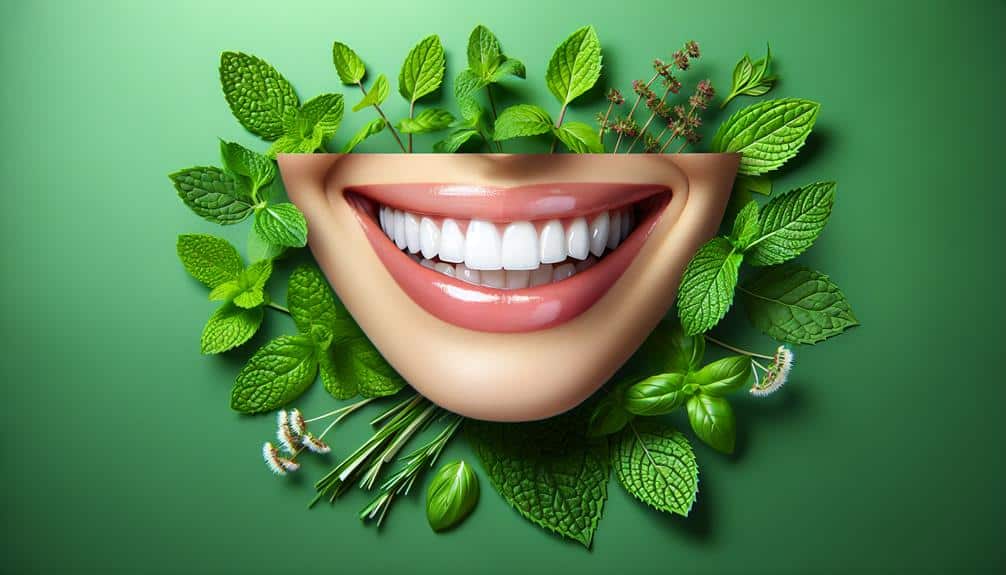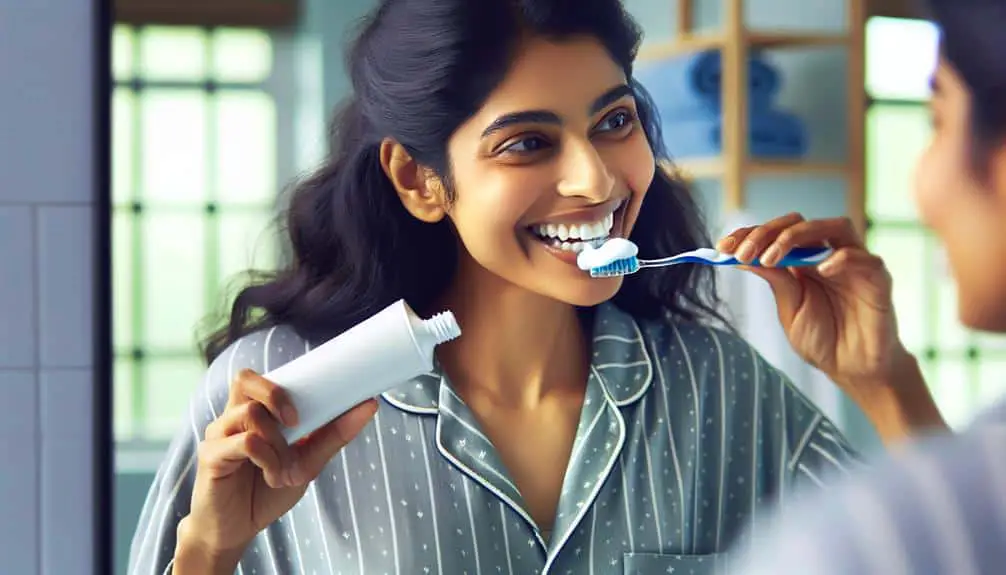When using microbead toothpaste, brush gently in small circular motions to avoid abrasion on your teeth, choosing soft bristles and gentle pressure. Remember to use a pea-sized amount of toothpaste and rinse thoroughly for at least 30 seconds to prevent microbead accumulation and promote fresher breath. Be careful not to swallow toothpaste, especially the microbeads, and store it in a cool, dry place to maintain its effectiveness. If you experience any irritation, stop use and seek medical advice for alternative options. Master these tips for excellent oral care and dental health.
Key Points
- Use a pea-sized amount of microbead toothpaste to prevent overuse of abrasive particles.
- Brush gently in circular motions to avoid enamel damage from the microbeads.
- Rinse thoroughly to prevent microbead accumulation in the mouth.
- Store microbead toothpaste properly to maintain the integrity of the active ingredients.
- Supervise children to ensure they use the appropriate amount and prevent ingestion risks.
Brush Gently to Avoid Abrasion
To prevent damage to your enamel, gently brush your teeth using microbead toothpaste in small circular motions. It's essential to employ the proper technique to guarantee effective cleaning while avoiding potential harm. When selecting a toothbrush, opt for soft bristles to facilitate gentle cleaning. Soft bristles are more forgiving on your enamel and gums, reducing the risk of abrasion. Remember, the goal is to remove plaque and food particles without causing unnecessary wear on your teeth.
When brushing with microbead toothpaste, be mindful of the pressure you apply. Excessive force can lead to enamel erosion over time. By using light pressure and small circular motions, you can effectively clean your teeth without causing damage. Additionally, focus on reaching all surfaces of your teeth, including the back molars and along the gumline.
Incorporating these practices into your oral hygiene routine will help maintain a healthy smile while preserving the integrity of your enamel. Proper technique and gentle care are key to preventing damage and promoting ideal oral health.
Use a Pea-Sized Amount
Using a pea-sized amount of microbead toothpaste is recommended for best oral hygiene. Proper application of toothpaste is important for maintaining good dental health and preventing potential issues. When it comes to toothpaste safety, less is often more. A pea-sized portion is sufficient to effectively clean your teeth without the risk of overuse or unnecessary exposure to the ingredients in the toothpaste.
Applying more than the recommended amount of toothpaste can lead to excessive foaming and may cause you to swallow more fluoride than is considered safe. Fluoride is an essential ingredient in toothpaste that helps prevent tooth decay, but ingesting large amounts can lead to fluorosis, a condition that affects the appearance of tooth enamel.
Rinse Thoroughly After Brushing
After brushing your teeth with microbead toothpaste, make sure to rinse thoroughly to remove any remaining residue and maintain peak oral hygiene. Proper rinsing techniques are essential to ensure the effective removal of microbeads and leftover toothpaste. To optimize your rinsing routine, follow these tips:
- Use lukewarm water: Lukewarm water helps in dislodging any remaining microbeads and toothpaste particles from your teeth and mouth.
- Rinse for at least 30 seconds: Thoroughly swish the water around your mouth for a minimum of 30 seconds to guarantee all debris is washed away.
- Pay attention to all areas: Focus on rinsing the front, back, and chewing surfaces of your teeth to guarantee a thorough cleaning process.
The benefits of thorough rinsing include reducing the risk of microbead accumulation, preventing potential irritation, and promoting a fresher breath. By incorporating proper rinsing techniques into your oral care routine, you can maximize the effectiveness of your microbead toothpaste and maintain excellent oral health.
Avoid Swallowing the Toothpaste
Avoid ingestion of toothpaste to prevent potential health risks associated with swallowing microbeads and other ingredients. Swallowing toothpaste, especially those containing microbeads, can pose risks to your health. The microbeads in toothpaste are meant for cleaning teeth, not for ingestion. If swallowed, these tiny beads can potentially cause harm as they aren't designed to be broken down in the digestive system. Additionally, other ingredients in toothpaste, such as fluoride, can also be harmful if ingested in large amounts.
Toothpaste safety is essential, and preventing ingestion is key to maintaining good oral and overall health. To minimize swallowing risks, be mindful of the amount of toothpaste you use. Only a pea-sized amount is recommended for brushing. Teach young children proper brushing techniques and supervise them to make sure they aren't swallowing toothpaste. In case of accidental ingestion, contact a healthcare professional or seek medical advice immediately.
Store in a Cool, Dry Place
To maintain the quality and effectiveness of your toothpaste, it's important to store it in a cool, dry place. Proper storage is vital for preserving the active ingredients and preventing any degradation that can occur when exposed to unfavorable conditions.
Here are some key points to keep in mind:
- Product Expiration: Check the expiration date on the toothpaste packaging and make sure you use it before it expires to guarantee maximum efficacy.
- Temperature Control: Avoid storing your toothpaste in areas where it may be exposed to extreme heat or humidity, as this can alter its composition and effectiveness.
- Airtight Containers: Consider storing your toothpaste in airtight containers to protect it from moisture and maintain its freshness for a longer period.
Consult Your Dentist Regularly
Regular appointments with your dentist play an important role in maintaining excellent oral health and addressing any potential issues early on. Dental checkups aren't just about cleaning your teeth; they also allow your dentist to detect any problems like cavities, gum disease, or oral cancer in their early stages when they're more easily treatable. Your dentist can provide personalized advice on oral hygiene practices, including the use of microbead toothpaste, to make sure you're taking the best care of your teeth and gums.
Regular dental checkups typically involve a thorough examination of your mouth, teeth, and gums. Your dentist may also take X-rays to check for any hidden issues beneath the surface. These appointments are essential for preventing dental problems and maintaining good oral health. By staying on top of your dental checkups, you can address any concerns promptly and avoid more severe issues down the line. Remember, prevention is key when it comes to oral health, so make sure to schedule your regular dental appointments to keep your smile healthy and bright.
Do Not Use if Allergic to Any Ingredients
If you have known allergies or sensitivities to certain ingredients, it's essential to check the label of your microbead toothpaste. Allergy warnings are provided for a reason, and using a product that contains an ingredient you're sensitive to can lead to adverse reactions.
Always consult with your healthcare provider if you're unsure about the ingredients in your toothpaste.
Allergy Warning
In the presence of any known allergies to the ingredients, refrain from using microbead toothpaste. Microbead alternatives like silica, baking soda, or hydrated silica can provide similar benefits without the risk of allergic reactions.
Skin reactions to microbeads may include redness, itching, or swelling, indicating an allergy to the ingredients. It's crucial to be vigilant about potential allergens in toothpaste, as these reactions can be uncomfortable and may worsen with continued use. Consider consulting with a healthcare professional if you suspect an allergy to any toothpaste ingredient.
In addition, given the environmental impact of microbeads, it's worth noting that many countries have banned the use of microbeads in personal care products due to their harmful effects on aquatic ecosystems.
Ingredient Sensitivity
Allergies to specific toothpaste ingredients can lead to skin reactions such as redness, itching, or swelling, indicating a sensitivity that requires immediate attention. Caution signs of ingredient sensitivity may include persistent irritation, rash development, or blistering around the mouth.
If you experience any of these side effects, discontinue the use of the microbead toothpaste immediately and consult a healthcare professional. Common allergens in toothpaste include fluoride, flavors, preservatives, and certain dyes. Always carefully read the ingredient list before trying a new toothpaste to avoid potential allergic reactions.
Use for Recommended Duration
For best results, adhere to the recommended duration when using microbead toothpaste. Proper usage timeframes are designed to maximize the benefits of this specialized toothpaste, ensuring your oral health receives the full advantages it offers.
Here are key reasons why following the recommended duration is pivotal:
- Effective Removal: Microbead toothpaste's unique formulation requires a specific duration to work optimally, ensuring thorough plaque removal.
- Enhanced Whitening: Sticking to the recommended duration allows the microbeads to gently polish your teeth, contributing to a brighter smile over time.
- Long-Term Protection: By using the toothpaste for the prescribed period, you're aiding in the prevention of future plaque buildup and maintaining a healthier mouth.
Keep Out of Reach of Children
When using microbead toothpaste, it's important to keep it out of reach of children to guarantee their safety and prevent any accidental ingestion. Childproofing techniques are vital to make sure that curious little ones don't access the toothpaste unsupervised. Place the toothpaste in a high cabinet or a locked drawer to prevent easy access.
Additionally, teaching children about the importance of only using a pea-sized amount of toothpaste under adult supervision can further minimize the risk of ingestion.
Safety precautions should be taken seriously to avoid any mishaps. Always close the toothpaste cap tightly after each use to prevent spillage and make sure children can't open it easily. In case of accidental ingestion, contact a poison control center or seek medical help immediately.
Discontinue if Irritation Occurs
If you experience any irritation while using microbead toothpaste, discontinue use immediately and consult with a healthcare professional for further guidance on alternative options. Skin reactions can occur due to individual sensitivities to certain ingredients present in the toothpaste. It's essential to address any signs of irritation promptly to prevent further discomfort or complications.
Here are some important steps to ponder:
- Stop Use: Cease using the microbead toothpaste if you notice any skin reactions such as redness, itching, or swelling.
- Seek Medical Advice: Consult a healthcare professional, such as a dentist or dermatologist, to evaluate the irritation and receive recommendations for suitable alternatives.
- Explore Product Alternatives: Look for toothpaste options that don't contain microbeads or potential irritants to avoid future skin reactions and maintain oral health effectively.
Prioritizing your well-being is paramount, so taking action at the first sign of irritation can help you find a toothpaste that suits your needs without causing discomfort.
Frequently Asked Questions
Can Microbead Toothpaste Be Used by Children Under a Certain Age?
When it comes to safety concerns with microbead toothpaste, an age limit is essential. Children under a certain age should avoid using it. Consider alternative options like child-friendly toothpaste to guarantee proper dental care.
Are There Any Specific Toothbrushes That Should Be Used With Microbead Toothpaste?
When using microbead toothpaste, make sure toothbrush compatibility for maximum effectiveness. Opt for a soft-bristled brush to prevent enamel damage. Proper brushing technique enhances microbead benefits, reaching all teeth surfaces effectively for a thorough clean.
How Long Should You Wait to Eat or Drink After Using Microbead Toothpaste?
After using microbead toothpaste, wait at least 30 minutes before eating or drinking to allow the fluoride to fully function. Following this timeframe guarantees maximum benefits for your oral health. Remember to prioritize your dental care routine.
Are There Any Specific Dental Conditions That Would Prevent Someone From Using Microbead Toothpaste?
If you have dental contraindications or are seeking toothpaste compatibility, consult your dentist before using microbead toothpaste. Age restrictions may apply, especially for children. Prioritize oral hygiene and make informed choices for best dental health.
Can Microbead Toothpaste Be Used With Other Dental Products, Such as Mouthwash or Whitening Strips?
When mixing products like microbead toothpaste with mouthwash or whitening strips, be cautious of compatibility concerns. Some ingredients may interact, affecting effectiveness or causing adverse reactions. Consult your dentist for advice on safe combinations for best dental care.




